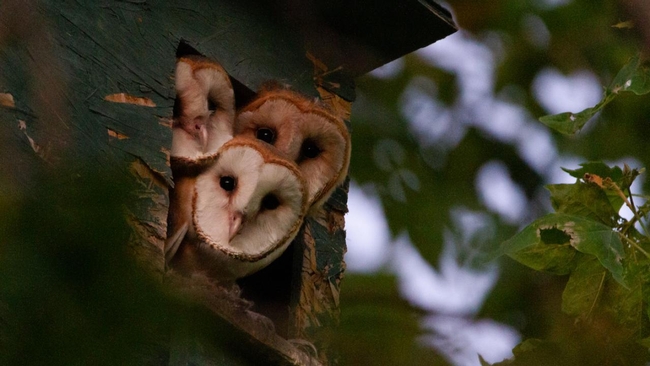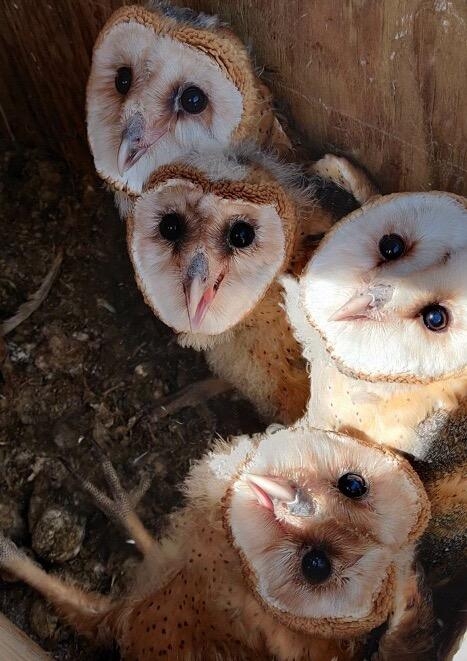
Posts Tagged: veterinary
Fall is best time to clean nest boxes for barn owls
Research shows land managers should clean nest boxes in autumn to avoid disturbing the raptors
When it comes to American barn owls, forget spring cleaning.
The best time of year to clean out nest boxes to ready them for breeding pairs is the fall months of September through November, according to research out of the University of California, Davis, that analyzed nearly a century of banding and other records.
In a paper published in the Journal of Wildlife Management, researchers found that the median egg laying date for barn owls (Tyto furcata) in California is Feb. 20, so cleaning nest boxes in the fall is recommended.
“The risk is you could disrupt a nest that has already started,” said lead author Ryan Bourbour, a Ph.D. candidate in ecology in the Department of Animal Science at the time of the study. “We want to reduce disturbances to nesting pairs even in the weeks prior to egg laying.”
American barn owls offer a natural way for land managers and agricultural operations to control pests, because the raptors eat mice, gophers and rats. One breeding pair can consume up to 2,000 rodents annually, according to the UC Davis School of Veterinary Medicine.
But natural tree cavities and old barn structures are not as plentiful as they once were, so installing nest boxes can attract the barn owls. And land managers who spend money installing these “nest box networks” have long asked about the best time of year to do maintenance and cleaning. Planning cleaning and maintenance well before the start of the breeding season is “part of making that nest box worthwhile,” Bourbour said.
Pellets add up
After eggs hatch, nestlings spend their early days eating and living in the nest boxes until they are able to leave the nest, said Breanna Martinico, another paper author and an animal science Ph.D. candidate in ecology.
The nestling period of roughly 65 days is considered long.
“That's two months where owls are living and growing exclusively in that nest box,” said Martinico, who is also a UC Cooperative Extension human-wildlife interactions advisor in Napa, Lake and Solano counties.
As many as five or six nestlings are typically in a box, and they eat up to four or five rodents each day. Nestlings swallow their prey whole, and what isn't digested — fur and bones — is coughed up in round or oval-like pellets.
“They're in there for seven to eight weeks just regurgitating these pellets,” Bourbour said. “A lot of pellets pile up over the course of a breeding season and a lot of these boxes need to be cleaned out.”
From anecdotal to data
Discussions about how early the breeding season starts have mostly been anecdotal. To get a better picture, the paper's authors analyzed 96 years of banding records from the United States Geological Survey Bird Banding Lab and 39 years of intake records from California Raptor Center at UC Davis. Both databases helped them estimate the typical egg laying time of year in California, Martinico said.
Having this information can help land managers ensure maintenance is done and nest boxes are safe for the next breeding pair, helping barn owl populations while also benefiting agricultural operations.
“We can give them tools to manage barn owl nest box networks effectively and maximize pest control through owls,” Martinico said.
Additional co-authors include Emily Phillips, Jessica Schlarbaum and Joshua Hull in the Department of Animal Science, Michelle Hawkins in the Department of Medicine and Epidemiology at the UC Davis School of Veterinary Medicine and Sara Kross from Columbia University.
Funding came from the National Institute of Food and Agriculture's Western Sustainable Agriculture Research and Education program.
The journal article is entitled Banding records of nestling barn owls reveal optimal timing for nest box maintenance in California.
Veterinarians Registering Now for UC Davis-OSU Honey Bee Health Course
If you're a veterinarian or a veterinary technician in California or Oregon, then you'll want to register for a free online bee biology course aimed at training veterinarians in their new role in supporting beekeepers and maintaining the health of bee colonies. Honey bee experts at UC...
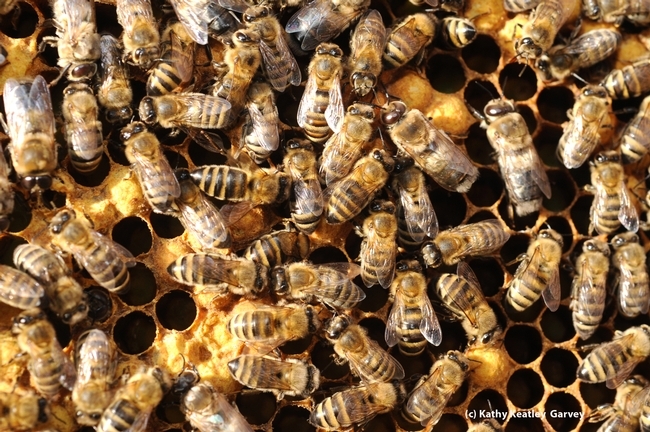
Inside a hive. (Photo by Kathy Keatley Garvey)
UC helps California dairy farmers experiment with milking robots
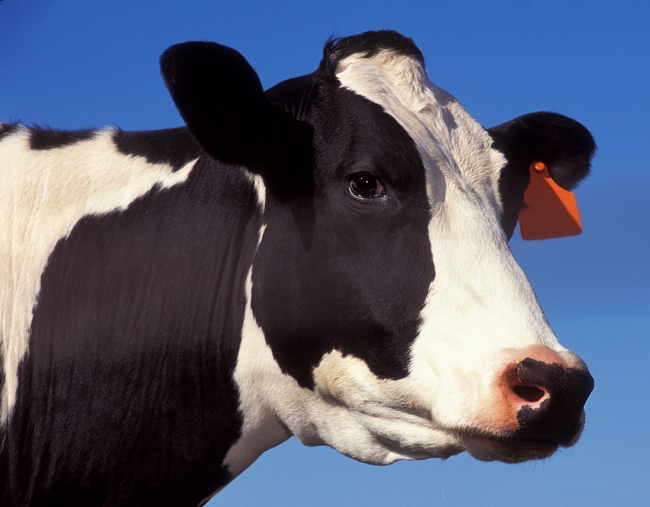
The technological developments were critical to the formation of California's enormous dairy industry, the largest in the nation. Today, more than 1.7 million cows produce 39.8 billion pounds of milk in California each year, according to the California Milk Advisory Board.
The march of progress continues. The state's dairy industry is now beginning to integrate robots and sophisticated computer software into cow barns to maintain the supply of wholesome and inexpensive dairy foods for Americans. UC Cooperative Extension scientists are poised to help them adapt to the new technologies.
On most California dairies, cows are led two or three times each day from the barn to the milking parlor by workers. They clean the cows' udders to remove bacteria and surface dirt, evaluate whether the cow has mastitis, attach the milking machines, and disinfect the cow's teats after milking before taking the cows back to their pens.
“Dairy production is automated, but it is still a very labor intensive activity,” said Fernanda Ferreira, UC Cooperative Extension dairy specialist based at the UC Veterinary Medicine Teaching and Research Center in Tulare. “Farmers always tell us that the most challenging thing they are facing is labor – labor availability, training and cost.”
Milking robots – a technology already being used in dairies in the Midwest and Eastern U.S., Europe, South America and Canada – promises greater automation, reduced labor needs and improved animal welfare.
View a short video clip of the milking robot in action.
The machines don't resemble a stereotypical robot character, but rather are computerized boxes large enough to fit one cow, with a robot arm programmed to reach under the cow and clamp onto the teats. Cows do not need to be led to the milking machine, but rather walk into the box voluntarily when they are ready to be milked.
The machine recognizes each individual cow by a computer tag around her neck or on the ear, and provides personalized milking service. The robots do all the work: clean the teats, attach the milking machines, and disinfect the teats after the milking is done. While milking, the robot collects data on the cow's output and health.
When it comes to California and all the West, these are very new,” Ferreira said. “We're talking herds that have 1,800 cows on average. Huge herds. Since each of the robotic units, which serve 60 to 70 cows, costs about $120,000, we're also talking about a huge investment.”
Two San Joaquin Valley dairies have already installed milking robots, and many others are interested in the new technology. Ferreira and other researchers from the VMTRC in Tulare are collaborating with one of them to study how the machine and the herd's management can be adapted to better serve large-scale dairy herds like those in California.
“Our idea is to first understand the perspective of the producers who have cows being milked by robots. We want to know what they have learned so far, the challenges they have encountered, their relationship with banks,” Ferreira said. “Relationships with banks are important because most dairies will need to borrow funds to equip their facilities with enough robots for full automation.”
Future research will review issues of milk quality, mastitis management and determine what data farmers will need from the computerized system to improve dairy profitability.
“There are a lot of options available from companies that manufacture the robots. We want to fully understand how they work for our farmers and cows to be able to inform the future of California's dairy industry,” Ferreira said.
'Beekeeping and Management' Part of UC Davis Veterinary Medicine's Winter Conference
Mark your calendar! "Beekeeping and Management" will be part of the two-day UC Davis School of Veterinary Medicine's 2019 winter conference presented by its Center for Continuing Education in February 2019. The conference, covering several vet med topics or tracks, is set for Saturday and Sunday,...
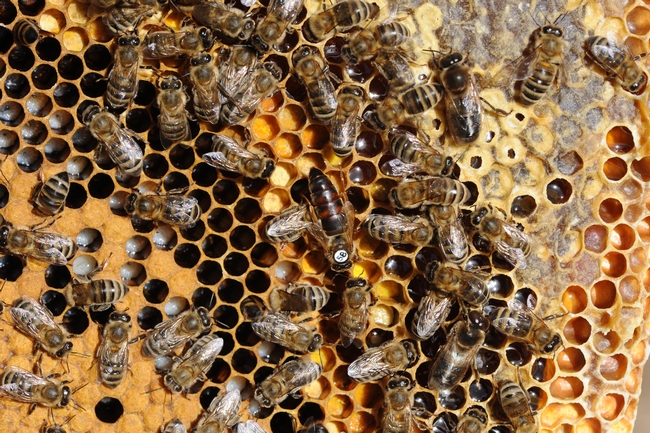
A honey bee colony at work. Extension apiculturist Elina Niño will discuss three topics dealing with "Beekeeping and Management" at the UC Davis School of Veterinary Medicine's 2019 winter conference. (Photo by Kathy Keatley Garvey)
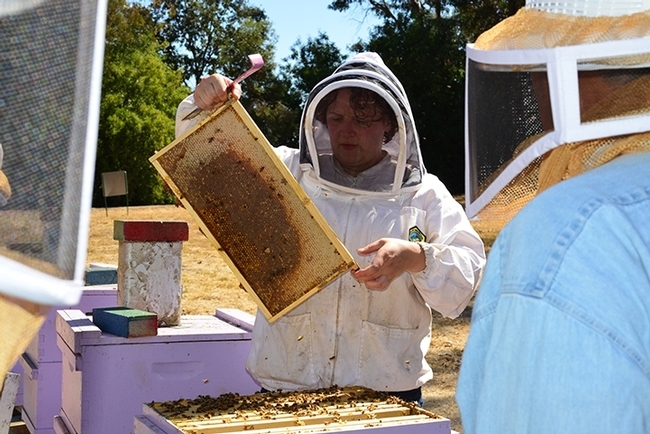
Extension apiculturist Elina Lastro Niño opening a hive at the Harry H. Laidlaw Jr. Honey Bee Research Facility, UC Davis. (Photo by Kathy Keatley Garvey)
Zeroing in on the Zika Virus
If you're interested in Zika virus research, you'll want to attend Lark Coffey's seminar on Wednesday, Nov. 7 at 4:10 p.m. in 122 Briggs Hall, University of California, Davis. Lark Coffey, an assistant professor in the Department of Pathology, Microbiology and Immunology, UC Davis School of...
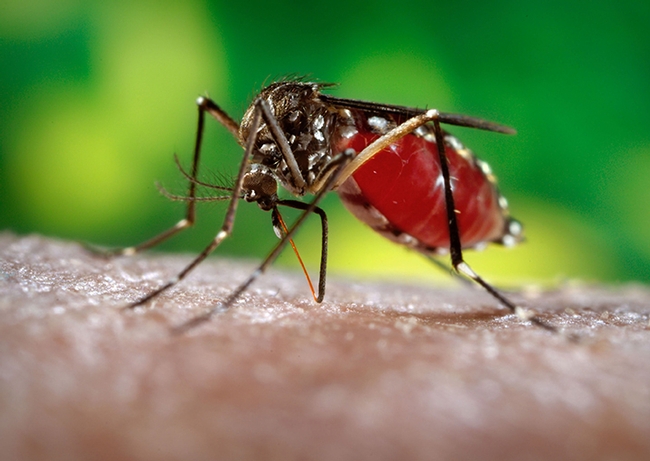
This mosquito, Aedes aegypti (infected mosqutoes can transmit such diseases as dengue and the Zika virus) will be the focus of Lark Coffey's seminar at 4:10 p.m., Wednesday, Nov. 7 in 122 Briggs Hall, UC Davis. (Photo by James Gathany, Centers for Disease Control)

